Day Two of Prague: Rise and Shine! After seeing Alphonse Mucha's Art Nouveau stained-glass painting at St. Vitus Cathedral, we took a small detour and paid his mini museum a visit. But first, we went to see the Dancing House, a seeming Seussville house come to life for a quick photo. After gettin' jiggy with it, we hurried back to Nove Mesto or New Town Square. Unlike Stare Mesto (Old Town Square), Nove lacks charm and character though tries to make it up with its stretch of branded shops and stores. There were a few kielbasa stand's at the end, but nothing that stood out for us to linger further. That, or we were just too excited to see Mucha's work.
Fortunately a few blocks away from Nove Mesto, we reached the Mucha Museum early enough to spend time ooohhh-ing and aahhhh-ing at his anime-ish, pastel paintings. The museum, dissimilar from any we've seen, is relatively small. A 20-minute video of Mucha's life routinely plays at the back of the site while the rest of his work, hangs simply on ivory walls yet leaving us wanting to see more. The paintings were absolutely unique and beautiful. Wrapped in flowers, vines, flowing dresses, fading pastel colors, and evocative women, Mucha's work is easy on the eye and inspires anyone who sees it. Some of his works are posted at the Mucha Foundation website, which contains more information and details about his life and works. After Mucha, we went straight to see Prague's Jewish Quarters. Debated on whether to go inside the sights or not, we finally bought our tickets at a queue-free souvenir shop across the Old-New Synagogue. The Old-New Synagogue, the oldest in Europe, stands out from its neighboring Nouveau-painted buildings with its serrated gables and rice roofing brought together by its brick red, tawny and rusty hues. The synagogue's nave interior was simple. Backdropped with high ceilings and narrow windows, it comes with a wood wall-seating good for maybe forty people, the bimah in the middle and the elaborate Ark housing the Torah. The Klausen Synagogue and the Ceremonial Hall, situated near the Jewish Cemetery, exhibit Jewish traditions and festivals. We visited the Ceremonial Hall first where it presented burial customs. In Jewish law, the dead is never left attended until the person's buried as a sign of respect and burials preferably happen within a day or two after the time of death. It's also customary to leave stones and even pieces of paper containing prayers on top of their headstones (as we've later seen in the cemetery) as a remembrance of them. In addition, many Jews enter the field of medicine, not solely because for their love of science but a Sacred Duty to help those in need.
While the Hall focuses mostly on a person's death, the Klausen Synagogue presents the Jews' everyday life - birth, circumcision, marriage and festivals. Upon presenting our ticket, we were welcomed by a charming old man, sitting behind the ticket counter while picking his nose with his pinky, eyes closed. Ralph and I, grinning ear to ear, dared not disturb his ritual. "Halo!" he finally greeted, now wide-eyed. "Halo!" we responded, still grinning as we walked past him and inside Klausen. Obviously newer than The Old-New, the Klausen looked more like a museum than a synagogue. It exhibited some circumcision tools, kitchen wares, religious items, wedding gifts and even a chuppah! The breaking of the glass in a wedding ceremony is said to be reminder of the sadness and destruction of the Temple, and should be remembered even in the midst of jubilant festivities. Mazel Tov!
Prague, Czech Republic in Pictures For dinner, we ate at one of the most beautiful cafe's I've ever seen - Kavarna Obecni Dum at the Municipal House. It's high ceilings, light and airy colors, wooden tables and chairs - makes up its Nouveau interior. Surprisingly affordable, we ate a meal of omelette's, soups and side veggies. Food and ambience was great but the service, not so much. Our aggressive waitress was rude and totally off-putting. With two hours to kill before the light show at 8PM, we finally enjoyed the rest of Old Town Square, where the Astronomical clock, Easter shops and Trdelnik, roasted cinnamon bread, abound. We capped the night with the long-awaited Image Theater's, Afrikannia, a story of a married couple vacationing in Africa. The show had an open-seating and was immediately filled. But the elevation of its seats failed to consider people 5' and below. Sitting beside two kids, we practically had to crane our necks above the crowd for the whole time to the dismay of those behind us and the unnecessary guilt of those in front. Thanks to this one minute clip from Image Theater's Youtube Channel, I can relive a short part of it in the comforts of my own home.
Tram 22 was predictably jam-packed by tourists but we didn't mind. Public transportation has always been part of our Euro adventures, a must-do in every city. The dread of getting completely lost, the anxiety of going around in circles, the pressure of time and the satisfaction of finding our way yet again always roll up in one big ball of unforgettable memories. And by the time of our Prague visit, we were masters of navigating the thousand rails and bus routes, and the art of squirming through lines and crowds. So when Ralph and I found ourselves hanging on tram poles and handlebars sandwiched between unfamiliar, sweaty faces, we knew Prague was going to be a walk in the park.
That early April morning day started a bit fickle, the undecided sky trotted back and forth whether to concede to the threatening heavy clouds or succumb to the sun's mighty light. Though scattered light showers came over the city, it miserably failed to deter us or the throngs of aviator-wearing, camera-ready peeps from taking Prague Castle by storm. Like the Buckingham Palace, nutcracker-esque guards in carefully ironed uniforms stood outside their rectangular-shaped shed, stiff and annoyed, perhaps, by the thought of their faces plastered all over Facebook or blogs. The towering spires of St. Vitus Cathedral, one of the three chapels of the castle, commanded attention and hovered over us as we obligingly craned our necks to appreciate its beauty. Mixture of grays, creams, greens, yellows and blacks color its facade, making it look like an aging yet stylish castle of its own. Its various gargoyles adorning the walls patiently wait to spill water away from its variegated marble. We opted out of the tour and enjoyed the stained glass nouveau and the neo-gothic interior from the designated space barricaded by steel stanchions serving as the chapel's lobby. By lunch time, we had toured and taken pictures of the castle grounds, and had reached Wenceslas Square, where a four-man orchestra serenaded the crowd while we waited for the castle's so-so changing of the guards. After the castle, we crossed the buzzing Charles Bridge running across Vlatva River. Connecting Prague Castle and the Old Town Square, Charles Bridge is unsurprisingly overcrowded with tourists and locals alike. Not only do vendors, mostly painters selling their Prague portraits at a slightly higher price, populate the place but interesting statues backed by legends, myths and twisted facts spanned throughout. The most famous statue, St. John Nepomuk's, is said to bring good luck if its bronze tripartite base is rubbed. Having seen enough for our first day, we briskly visited Old Town Square in search of the Black Light Image Theater. Off of the main square, we spotted its simple, lemon sign hanging above in black poles. Ticket's reserved for tomorrow's show, we headed back to our modern and clean hostel/hotel to unwind, in anticipation for another backpacker's day - Nove Mesto, Mucha's, Jewish quarters, Dancing House, Municipal House, Stare Mesto and of course, the light show.
Auschwitz II or Auschwitz-Birkenau is ten times larger than the first, though vaguely similar yet magnified in purpose. Dusty and wide, its red buildings unsurprisingly resembled Auschwitz I. Its acres of grassy land, fenced in by lengthy barbed wires masquerade like a recently developed park waiting to be filled with graffiti. When we arrived, other tour groups were already huddled in a specific area - some caught in a trance of I could only imagine, caused by the horrific stories of camp life, while some, shaded away from the sun's prickling light, loitered under the main entrance. We walked past the fading gate popular for its appearance in Schindler's List to be welcomed by two railway tracks. We would later find out its main purpose - one for incoming prisoners, the other, for picking them up. To its right lies the washed-out carmine barns, some of it carefully preserved while others show marks of it going up in flames.
Reluctant to lose any time, our guide led us to the first shelter known as the prisoner's communal toilet. Hitler and his men with their deranged idea of racism really thought little of their prisoners. Empty and hollow, long trenches with cemented toilet openings act as the camp's urinal. It was the poorest living conditions at its finest. Lined up, thousands of prisoners were only given a few minutes to use them during specific breaks, otherwise, they do not get to use them at all. Some prisoners also worked here, scooping out the mushy feces of their relieved fellow inmates. Ironically, this is one of the "best" places to work around the camp - the Nazi's, afraid of catching diseases, left the workers to themselves and stayed away from it. The camp dorms looked exactly like the communal toilets outside, while exchanging its shoddy concrete urinals into tightly squished bunk beds. No fancy wallpaper or elegant furniture, just some thin roof, thin walls, and cheaply made bunks of three. Straws were the only bedding used and rats, a nasty companion. Eight or more prisoners slept on each bed, whom were often caught fighting to secure their place on the top bunk. Bathroom or bathroom breaks during bed time were prohibited, which means, the ones on top misses out on the flow of piss and the slow slump of excrement throughout the night.
As we moved out into the field, we walked towards the railway tracks that greeted us where a windowless railcar stood. This, our tour guide said, is one of the original cars used to transport the Jews into Auschwitz, mostly Hungarian Jews. Packed with prisoners, thousands of deaths occur here even before it reached Auschwitz - suffocation and starvation, mostly the cause. Once in the camp, prisoners' fate were no different. Deviously welcomed by an SS commander and his troops, the commander would ask prisoners to line up in two. On the right - young, robust men ready for work. On the left - children, women, old and sick men, deemed useless. Those in the right would live for another day as slaves, and the other, would be asked to "take a shower," a Zyklon B shower. Families, friends and loved ones would see last of each other here.
Germany or the Germans, a far cry from their dark, Nazi history today (we jokingly consider Germany our second European home), have always been efficient. And that efficiency spread throughout the camps, especially Birkenau. The gassing of the prisoners came easy for them, but it was the ridding of the bodies, the burning of the bodies that took longer. Hence, they sought to build more and bigger crematoriums. But the deaths were too numerous to count, numerous than the crematoriums could handle. So the Nazi's burned their bodies on an open fire. And unlike Auschwitz I's crematorium still intact, what was left of Birkenau are ruins. The Nazi's, in hopes of covering up their crime, tried to burn everything down. But the cry of innocent blood were much louder than those of its crackling flames. Escapee's and sympathizers had been secretly taking pictures and passing the horrendous info along to the rest of the world. And by the time the allies came, they already had a general idea of what's going on at these concentration camps before Birkenau finally saw liberation's light.
The sun was at its mid-afternoon peak, the wind dry. The first few groups we've seen earlier had headed back out, replaced by new saddened and stunned faces. Our group slowly dispersed while some stayed with our guide, asking more questions upon questions. I had them too, about those who escaped. How did they do it? How did they not get caught? But those questions were selfish and trivial. I only hope to find some assurance that there must be something good to celebrate on, that amidst its haunted history, Birkenau, took mercy and set others free. But as if Auschwitz knew my heart's content, the tour guide became occupied with other tourists that to wait for her meant missing the bus in half an hour. So Ralph and I decided to explore the rest of Birkenau into the woods. We kept the mood light, joking how the German's are still the same - efficient, but the atmosphere refused to improve, remaining somber. There was a silence that passed between Ralph and I, imagining that the same unpaved road we were trudging on were the same ones, prisoners, workers and Nazi's trudged alike, that the same unpaved road carry strewn human ashes. We passed by guard houses, tall trees, and ponds then hesitated to go even further and peek at the last building standing in the area. The bus might leave without us, was our excuse but deep within, sadness. Saddened by the sound of the eerie air, the cacophony of innocent, hollow cries.
Krakow, Poland in Pictures
We arrived Krakow, Poland at 6:00AM ready to tackle the place we came there for: Auschwitz I & II, two of the worst concentration and extermination camps during the Nazi reign. After dropping our bags off at the luggage room, reserving our train tickets to our next destination (Prague, Czech Republic) and dilly-dallying around the station looking for the bus to Oisweicim, we finally left Dworzec Glowny at 0800AM and reached Auschwitz two hours later. I didn't really expect anything from this visit, in fact, I didn't do much reading or cared to research anything about it. I knew it was a Nazi concentration camp, but that was the only card I have. I really wanted the element of surprise. I wanted to see and experience it with fresh eyes, like skipping all the preface and introductions of a really good book. I wanted the biases of other people's commentary out of my thoughts so I can create mine. And wow, was I blown away. Not because it looked aesthetically pleasant but because it showed how cruel we all can be. Now I clearly understand why there were skeptics about the existence of this place. Now I clearly understand why it is necessary for other countries to step in when the greatest crime against mankind is committed. Now, I fully understand.
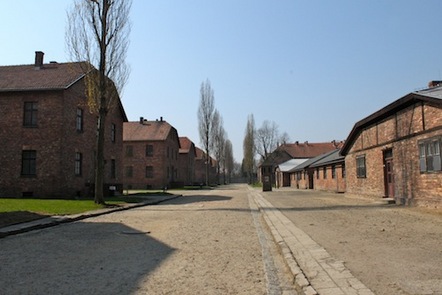 Auschwitz I Camp Grounds We were a couple of minutes behind the scheduled English guided tour, but from half a mile away over our receivers, our tour guide's voice echoed with calmness yet controlled intensity. Already, she had set the tone of our journey through Auschwitz as her "Ladies & Gentlemen" greeting sounded eerie. Slowly approaching the Auschwitz I camp grounds, we were welcomed by the infamous gate sign, Arbeit Macht Frei, which literally means Work Makes Free, an unsettling sign, for what is freedom in the Nazi vocabulary? A couple of feet away from the gate, we stopped at the spot where an orchestra once stood. The musicians, all of which were prisoners, acted as a ploy for newly arrived and unknowing prisoners (about ninety percent of whom were Jews) to think that camp life was Utopia. Who would've thought?
The open spaced grounds now looked deceivingly simple - red brick houses lined the wide slightly paved roads where trees of pine and occasional trash cans accompany them. But in the 1940's of course, the roads were but dust and the grass and trees were absent. Rain, shine or snow, prisoners would stay out here in the streets for hours as punishment when one of them is found missing during roll call. Each house is called by a specific number (i.e. Block 10, 11, etc) and one of the first few we ventured in were Blocks 4,5 and 6. These blocks, now turned museum, showcased tons of empty Zyklon B cans, the poison used at the gas chambers, luggages, glasses, combs, shoes, toys, pots and pans, prosthetics - all collected from the Jews, photos of the victims lining up the walls, and the strangest exhibit of all - tons of human hair. After being gassed, these human hairs were cut off from the victims as Germans used and traded them for the production of various textiles. Then comes Blocks 10 and 11. Block 10 was notoriously know for its Medical Experiments on infertility, babies, pregnant women and twins. One of the prominent medical experiments included mass sterilization - the Nazi doctors would inject foreign substances in the women's wombs to close up their fallopian tubes. At times, toxic substances were also rubbed into a victim's skin to test its effects. Prisoners (men, women, children) were also immediately killed only for these doctors to dissect them.
Block 11, on the other hand, was the punishment cell. Prisoners were tried here for different reasons and were either starved, hanged, flogged and/or eventually killed by a firing squad. At least three 3x3 single cell, only accessible by crawling through a small opening, also existed behind these walls. As a sanction, victims were asked to stand here in attention for days with at least three other people per cell, causing exhaustion and suffocation. It is also in this same Block did the Germans first tested the use of Zyklon B. The last stop of our tour was the Gas Chamber and the Crematorium. Here, prisoners were asked to undress and were lied to think that they were going to take a shower. Fake shower heads were installed and small ceiling holes were carved out. The shower heads to cover the lie on top of a lie, the ceiling holes to dump the Zyklon B gas inside. This building also houses two furnaces used to burn at least three to four cadavers after being suffocated to death. About 4,000 bodies were burned here in a day. And unfortunately, some prisoners were tasked to work here so it was not uncommon for them to see and cremate the bodies of their friends and family.
By the time we ended strolling the stretch of Andrassy Ut, we arrived at our final destination of the day- Szechenyi Baths, a spa complex with an indoor/outdoor pool filled with natural, thermal water. Starving for some splashy summer fun, we eagerly dipped into the pool's warmness and enjoyed the whirling/jacuzzi pool playing tag and rescue with the locals parading in their tight bikinis and speedos. Beat that 40ºF weather! It was simply the best way to end our long and tiring day. Following morning, we set our sights on Buda, then a light bulb moment - How about if we go to Memento Park? A brilliant idea. But as soon as we stepped out of that tram to take the supposedly Memento Park bus, that brilliant idea's light bulb slowly flickered. We spent at least an hour scurrying the city for that freakin' stop for Bus #15! But no way we were giving up.
"Okay, how about that one? or that one? No! Bus 15 is not in here. Let's cross the street!"
Across the street...
"#17A, 17...there's no 15! Crap! Okay, let's retrace our steps or maybe we'll just stay here in Buda...Nooooo!"
After retracing our steps...
"Wait, how about that one! There's a lot of people there who looks like they're tourists. Yes! Yes! Yes! Ruuuun!"
At the bus stop where a lot of people looked like they were tourists...
"12...15! This is it! This is it! YESSS!"
And five minutes later...
"Two tickets to Memento park, please. Whew!" Memento Park After our half-day trip at the park, we went around Buda before going back to Pest. We visited the beautiful Matthias Church, with its fish scale like roofs standing out against its white, marble, walls; walked around Castle Hill and saw the Royal Parliament's majestic beauty from afar, crossed the chain bridge guarded by the fading aqua green lions, saw the expensive Gresham Palace a.k.a. Four Seasons Hotel, and St. Stephen's Church. But before bidding Budapest farewell, we grabbed a cheap and scrumptious dinner at Belvarosi Lugas Etterem. No way we would have left Hungary, hungry, as we were bound for another 8-hr train ride to Oisweicim & Krakow, Poland. Budapest, Hungary in Pictures
"We are sooo not ready for this trip!!!" I exclaimed as Ralph and I crammed our already wrinkled clothes in our already stuffed bags.
"I know yeah, baby.." Ralph snickered, finding the chaos, the rush, thrilling and amusing. But five minutes before our first connecting train to Budapest, he stopped poking fun at our own self-inflicted, procrastinated mess. He had switched his military watch on and begged me to hurry up, "The train doesn't run on your time, Jezell."
Great. Now even his military tone is on. Scrambling to tie my gray chucks' bunny ears, I told him I'll meet him at the station. Having gone through my travel checklist, I seemed to have slowed down, obviously taking advantage of the fact that we live about 50 feet away from our town's little train stop. And about a split second as I headed through our mini, steeled gate, the chugging sound of the railroad cars came squeaking to a halt. Relying on the couple of days spent at the gym, I dashed to meet Ralph, down the underpass stairs and up, until we finally grabbed an empty dark blue, vis-a-vis train seat. Oh, hello puff first puff train connection, we puff meet puff again...Puff, puff, puff.
13 hours later...we stepped foot in Pest. Getting better at navigating and familiarizing ourselves with public transportation, we found our hostel, checked-in and went straight exploring the latter side of Budapest - Pest. First stop - FOOD! Hoping for some cheap eats, we took the metro to the Great Market Hall. Fresh fruits, vegetables, sausages, bread, ham, and lots and lots of red hot chili peppers tied with garlic, colorfully welcomed us. Up the second floor, we found various handmade items and souvenirs together with an array of food stands lining a narrow hallway. Craving for some sort of meat and wanting to try something Hungarian, I immediately went straight to order this fist-sized looking meatballs and some sauerkraut. It looked devilishly appetizing but somewhere in between my high expectations, unsophisticated palate plus eyes bigger than my stomach, it proved fatal. It was shaped like a meatball alright, but it was definitely not meat!
"How's your's?" Ralph munching his delicious sausage away. I hesitatingly shook my head, hoping that the Hungarians beside me won't recognize my distaste. But they did. And one of the older women looked half-baffled, half-offended. I know, I know, lady. I should've taken the food most familiar to me. I should've eaten the goulash. But where's the fun in that?
After a quick tour around the Market Hall, we went sightseeing at Budapest's main street, Andrassy Ut. By three o'clock, we have reached the opulent Opera House. Mulling over whether or not to take the guided tour at four, we walked a few blocks away to the House of Terror, a museum about communism and not the haunted house I thought it would be. Bummer. So, Museum or Opera House? Opera House or Museum? Two out of two, Opera House wins. At the Opera, we opted to go for the guided tour with an included mini-concert tickets. Having made his introductions, our lanky guide led us inside the slightly dimmed auditorium, making its cardinal and golden ceilings, posts, seatings and curtains shine brighter than sun, a sure sign warning that slightly touching it we'll turn us all into gold. He also pointed out the special balcony seating of the Hungarian's Prime Minister, right at the middle with the best view of course! Then the wooden panels and flooring specifically made so the orchestra's sound bounces back better. It is also said that in this very Opera House did Madonna filmed the part in Evita, where she sings Don't Cry For Me Argentina. Hmmmm...another tidbit for our pockets.
If you would have asked me eight years ago, if I was going to see at least part of Europe, my answer would be Yes! but only in my dreams. Never did it crossed my mind that I was going to have this amazing opportunity to travel, much more to travel with Ralph. So allow me to THANK GOD for such an incredible blessing. Actually, during our second or third day into our traveling, I was reminded of this verse, this promise/caution I got eight years ago before I left the Philippines. When I first read it, my initial thoughts were God will bless me if I don't forget Him. But to my surprise, God had literally fulfilled this promise. As to why God poured these blessings over and beyond, I cannot say for sure. Though this, I very well know, it is certainly NOT for what I have done, did or doing (far from it) and most certainly NOT for who I am. And that dear readers, I believe, is what's called Amazing Grace. When the Lord your God brings you into the land He swore to your fathers, Abraham, Isaac and Jacob, to give you - a land with large, flourishing cities you did not build, houses filled with all kinds of good things you did not provide, wells you did not dig, and vineyards and olive groves you did not plant - then when you eat and are satisfied, be careful that you do not forget the Lord, who brought you out of Egypt, out of the land of slavery.
Deuteronomy 6:10-12 This journey has been a blessing from beginning to end, from our home and back. Favors were given, our prayers have been answered even to the minute, tiniest details. It was not just about Ralph and I learning lessons on marriage, but God just being sooooo good to us. Lord, I pray that we will never forget you under any circumstances, may it be amiable or dire, in plenty or in need.
With the trains sounding its horn, its wheels churning, we've crossed the borders of 13 countries, landed on 15+ cities in but a month. And it all began in the Paris of the East: Budapest, Hungary.
♫♪ Oh never, oh never oh never again
If I live to be a hundred or a hundred and ten
I fell to the ground and I couldn't get up
After drinking a quart of that Johnny Jump Up ♪♫
The Irish, known for orally passing their traditions in poems, songs or stories, sure knows how its done! Days passed, and here we are, still singing and remembering the folk songs we were taught during our recent two-day visit in Dublin, Ireland. Given that this trip was relatively short, we tried to see and do as much as we can: Book of Kells, Temple Bar, National Museum, Merrion Square, etc. but the Musical Pub Crawl and our visit to Kilmainham Gaol win the crowning moments of our tour.
The Musical Pub Crawl, a two-and-a-half hour entertaining and rather, informative bar hop about Irish traditional music and traditions, began at Oliver St. John Gogarty Pub and Hostel in the heart of Temple Bar street. Prettified with hanging colorful flags and painted with a bright lemon hue and touches of clover green, Oliver St. John Gogarty shouts Picture! Picture! for delighted tourists like us. As we learned later, the name Oliver St John Gogarty was from a popular surgeon and public figure known for his servitude and his eccentricities (i.e. selling a drunk friend for medical purposes).
Arriving half an hour earlier to score some tickets and snug some front row seats, we walked passed the already hyped-up bar crowd towards the thick wooden stairs up to the second floor where the crawlers meet. Agreeably devoid of any snotty rock star attitudes, the musicians/tour guides arrived and started on time, kicking the night off with our first real introduction to Irish pub tradition: stomp to the beat, instead of clap. Why? Takes no rocket scientist - people's hands are always well-utilized - food in the left and beer on the other. And, we were set - a slew of mostly flamboyant and giddy Irish tunes came wafting in the air. Welcome to the crawl.
Twenty minutes after, we went to the Ha'penny Bridge Inn, a family run pub within a 5 minute walk from Gogarty. It was named after the Ha'penny Bridge seen from right outside its window, which was coined from half-a-penny: the cost to cross the bridge when it was mandated way back. Unlike the Gogarty, which is carefully designed and was pretty crowded, Ha'penny's was the opposite. Perhaps too early for a visit from pub goers, our group had the pub to ourselves. It had a more intimate feel, exactly the setting for authentic Irish pubs, like you're entering someone's living room, our tour guide says. No fancy bright colors, no rococo banners, no flickering lights - only chairs, a bar and a small rostrum. Here, we learned some interesting nibbles about Irish music:
1. Having a good singing voice is only a plus not a necessity. As long as the person effectively conveys his/her story or message, then that's good enough.
2. In traditional pubs, musicians are hired to play music not to entertain. During a session, musicians play to their liking while the crowd are merely eavesdroppers to their musical conversation.
3. If the drums are the heartbeat in American bands, 'tis not so for the Irish - the dancers are. The dancers dance and the music adapts to the dancing.
4. The Bodrhan looks like a tambourine minus the jingles; it is played with varying miniature mallets and in our case, even a paint brush!
Our next and last stop was the Brannigan's, which I don't remember the Brannigan it was named after. The feel and setting of this pub comes right in between Gogarty and Ha'penny - newly painted and varnished, modern yet cozy. To wrap up the night, we had the "Noble Call," where the crowd gets to share songs from home or songs meaningful to them. How many more drinks will it take for you guys to think you're good enough to sing? our guides teased. Finally, two brave souls took the challenge - a ballad and a folk song, ending the night on a comforting high note.
 Kilmainham Gaol The following day, we visited Kilmainham Gaol, a historic site effusing with backstories of prisoners - men, women and even children as young as five. The gaol now houses a small cafe and a museum, and a visit inside are entered by tour guides only. After overcoming our bus stop confusion, we finally arrived at the jail just in time for the 1100AM tour. The tour began with a short video presentation inside the jail's chapel, immediately followed by a trip to the West Wing of the prison. Cells lined the dark and narrow hallway, enclosed by thick steel and wooden doors locked by a now rusty latch. Gas piping run atop the cell doors for heat and light replacing the then rationed single candle supposedly good for two weeks. Beside the doors, small hewn openings act as the police's spy window. Small windows were also carved near the interior's ceiling for prisoners to look up to the light, to look up to God.
The jail accommodates about 2000 inmates, however, became very overcrowded during the Great Famine especially when people began stealing and begging for food. The begging, which became a nuisance for some, led the government to declare the act as a crime, bringing the prison's population up to 9000. Ironically, this also became a refuge for the people during that time. The prison provided temporary shelter and a much needed steady supply of food, but conditions obviously worsened. Four to five inmates are held in a single cell while the rest flooded the hallways. Unlike the claustrophobic West Wing, the East Wing is a U-shaped area, designed so guards can have a 180 degree view of the cells. The grand staircase in the middle permits guards to easily access the upper level cells. At the other end, a spiral staircase rises up forcing detainees to walk in a single file and avoid any intended ruckus. Before acting as a tourist spot, carpets lined the East Wing prison doors allowing guards to walk and peek quietly without the inmates knowing. After Kilmainham Gaol closed it doors in the early 20th century, it has now become home to many movies (i.e. In the Name of the Father), music videos and even concerts.
Oh dear Weebly blog, how I have neglected thee, but certainly for good and not-so-good reasons. The past weeks whizzed by faster than the speed of light. I turned my resignation in from my previous job thinking I will get more time prepping for what is to come. So, what is to come Weebly? Concrete answers, I obviously have none, only hopes, plans and dreams. But what came, stooped and scooped me up from the blogosphere? uhmmm...well, some Wednesday cooking, intense studying, and some instantaneous traveling.
The cooking, which I enjoyed very much I did as a favor for one of our good "Ate's", but failed to find soon enough, how prepping weekly dinner for a 100 becomes quite the time monger. Between those culinary takes, my mind tried to wrap itself around math, science, language, social studies, US history and emergent literacy theories (WTH? my thoughts exactly). In a nutshell, the magic number was 22-6-4-2. After 22 years, I had to review all the lessons during my six years in elementary plus four years in high school in two weeks. Oh, and then some. Next thing we knew, it was a whirlwind visit to US of A via the military's space available flight - an almost free, first come first serve flight, if, an available plane arrives that is. Precarious, ain't it?
All these studying is really of course, meant to pass the required exams for this MA program I am applying for. Because what are the odds really that these exams are not offered in Italy frequently? So cue Michael Giacchino's Married Life. Bags packed and travel size toothpaste ready, we took our chance for a plane trip to Maryland. Fast forward 24-hour flight later, we embrace all convenience America has to offer. How we have become amnesiacs on the ease of finding things, points and places, of the wide roads and sensible signs, the ruins of communication barriers and oh yes, Pizza Hut's large, ultimate stuffed crust pizza for $12.99, an Oreo Sonic Blast, a Cherry-flavored classic slush and a classic Ben's chili dog! Nom...Nom...Nom. Talk about culture shock or should I say, culture mirth? And while still buried in books and historical websites with only about a week of leave, we managed to scratch some things off our Eat, Play, See lists.
✔EAT
Pizza Hut, Sonic, Chick & Ruth's Delly (Man v Food featured resto), Ben's Chili Bowl (Man v Food featured resto), Horace & Dickie's Seafood (Man v Food featured resto), Applebee's, Galae Thai Restaurant, Starbucks, McDonalds (hmmm...classic)
✔SEE
Washington Monument, The White House, Arlington National Cemetery, Smithsonian National Museum of Natural History, Lincoln Memorial, Reflecting Pool (currently under construction), World War II Memorial, Vietnam Veterans Memorial, Constitution Gardens, National Air & Space Museum*, Chinatown, Urban Outfitters, Library of Congress*, State Capitol*
✔PLAY
"Limitless" movie at an AMC theater, Visit one of our friends, Look for Sarah Vowell books, Pass (PASSED) the Praxis, and Talk-time with friends!!!!
This and all in hopes of becoming America's Next Top Teacher. Going back to Italia, well, that's a whole different story. In four words: Got.Stuck.In.Delaware. I guess, small is the gate and narrow the road towards those dreams. At least, this road was interesting.
*Ralph only =,(
If time were only tangible rooms I could easily come in and out of, I would definitely visit my childhood years time and time again. Growing up in the Philippines left no room for dull moments. On any given sunny Saturday afternoon, my friends and I would usually lie on our backs and make shapes out of clouds on a a grassy vacant lot, where clusters of wild, tiny red flowers bloomed. During rainy days, we would play in the rain; looked for water flowing through small rocks, imagining it as a mini-"ilog" or river and outlined suns on the ground, coaxing Helios to come out of its hiding. And those flimsy shacks built on whatever leaf, branches, and boxes we could put our hands on, those outdoor games played with sticks, stones and garters, and those rusty bikes pedaled into and through the fields - who, but Scrooge, can forget them? So though, I chose to permanently settle overseas, Philippines, my childhood home, will always, always have a piece of my heart. Despite the yes, yes, yes - abject poverty, rampant government corruption and creative modus operandi's, I daresay, Philippines or commonly known as Pinas, not only holds some of Asia's pure, unadulterated natural wonders but bears the most dauntless souls I have ever met and seen. So here's a look back on some of the visits Ralph and I had for the past five years. Hope you enjoy them as much as I did.
MANILA
Whenever someone refers to Manila, there's this popular Overseas Filipino Workers song always humming in my head, "Manila, Manila, I keep coming back to Manila..." And given the popular local and tourist spots: Rizal Park, Intramuros, Roxas Boulevard Baywalk, Malacanang Palace, malls and more malls, etc. etc, what I remember the most is the everyday life in passing as I sat inside a Tamaraw FX taxi stuck in the middle of early morning traffic. Children, teens, women - young or old, spend their time if not begging, selling cheap snacks or goods, commonly sampaguita garlands, on any consumer-filled street to fend off for themselves and their families. If the U.S. is the melting pot of nationalities, Manila is the boiling pot of ironies, where its flaws heighten its zest and piquancy. It is where the richest of the rich and the poorest of the poor exist. Audi's, BMW's and the Benz' roam the busy streets, while those in makeshift crutches rule the under and overpasses. Most people speak English and yet, there are those who remain illiterate. And despite the severe lack of food, almost ALL kinds of foods and restaurants thrive in Manila, from street foods sold in carts by local vendors, to the occasional gourmet prepared by visiting Michelin-starred chefs.
Crazy Irony. (L) Squatters area in Manila. (R) One of the thousand malls in the same city.
Photo Credit: Wikimedia
Wondering about theft? It's here. Worried about pickpocketing? Oh yes, they're here. Looking like any caucasian or even sounding like one, comes as a blessing and a curse. Those fitting this stereotype are either targeted by thieves and nodding sycophants, or welcomed by the warmest, most hospitable people. Just the nature of the beast. But Manila is one thing for sure; It is never boring - day in or out. It is for the vigilant yet adventurous. Simply taking a jeepney or jaywalking along the streets of Edsa poses a thrill in itself. Okay, perhaps, jaywalking in Edsa is a little too extreme, unless of course, you're a DC undercover cape crusader. So, opt for walking the under/overpasses instead, that too, can be quite interesting. A Travel Tip: If or when visiting, the safest bet is to take a friend who knows the culture and the place. Getting around then will be a cinch but traffic of course, is inevitable.
For now, here's a video of the song Manila originally sung by the Filipino band, Hotdogs in the 70's courtesy of Youtube. Here comes Homesickness, oh dear.
♫♪ Miss you like hell, Manila ♫♪
|
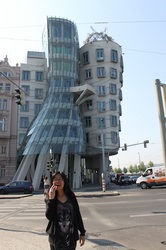
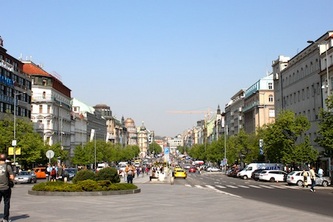
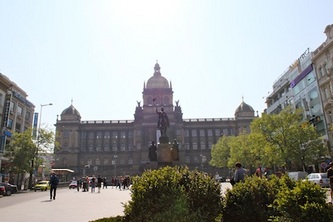
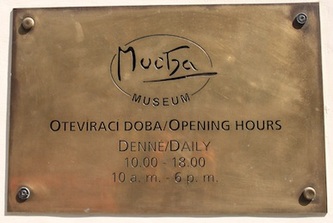
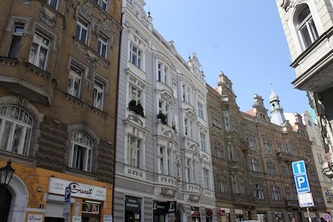
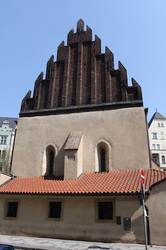
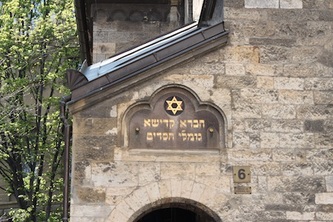
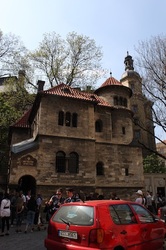
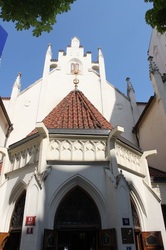
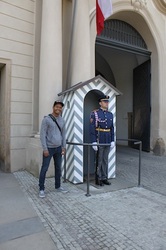


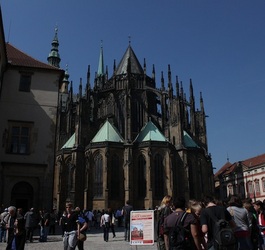

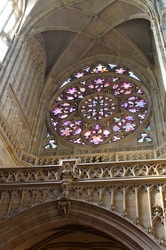
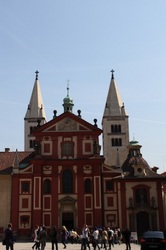
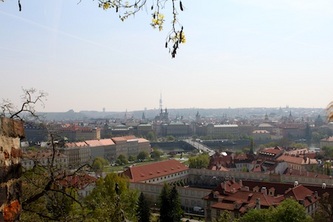
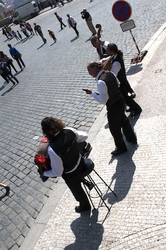
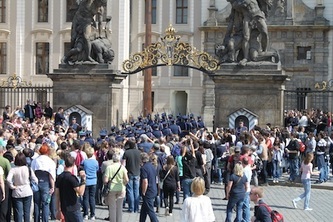

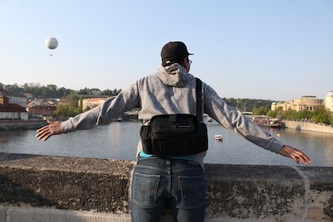
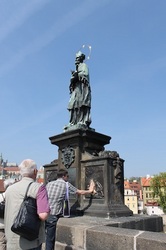
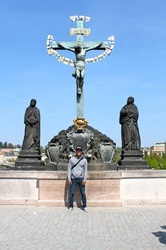
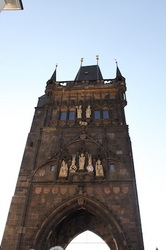
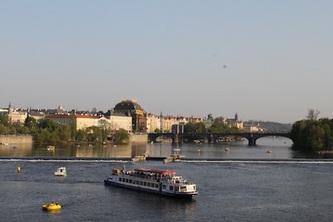
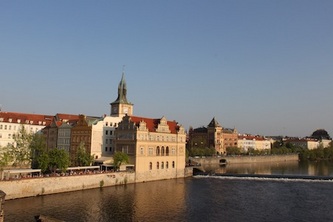

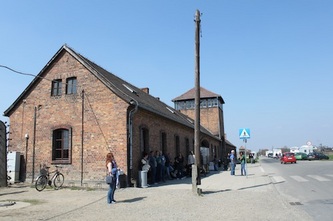

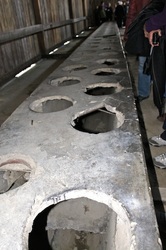

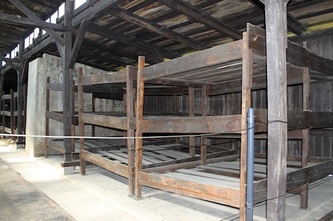
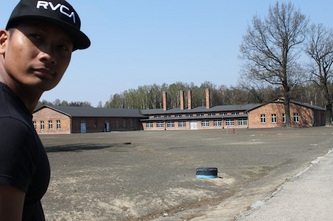

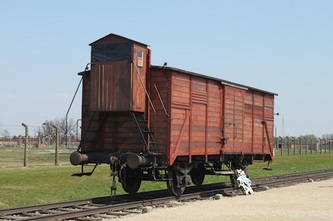
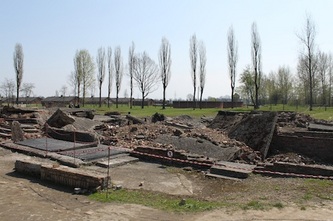
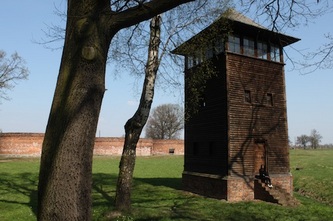
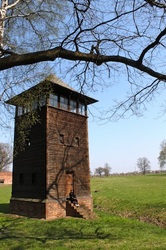

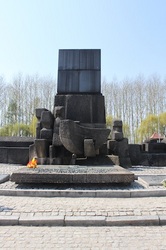

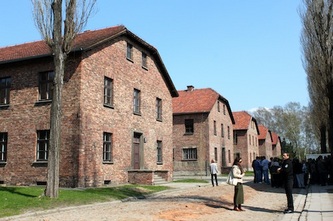
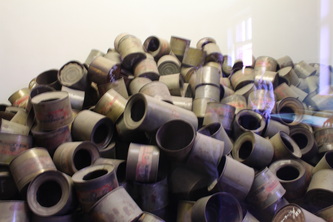
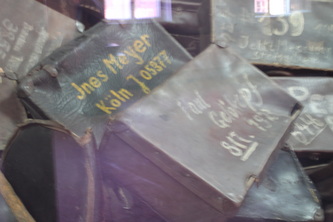
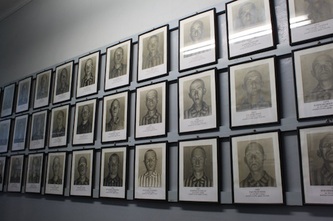
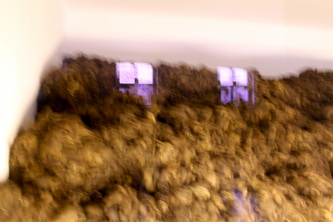
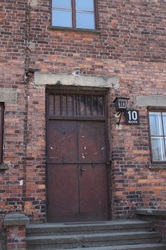

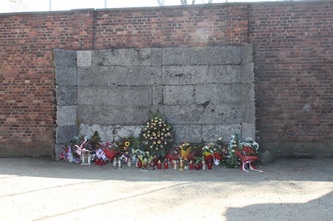
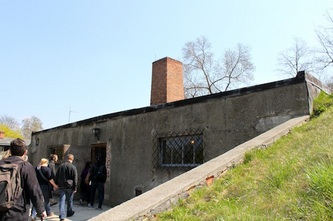
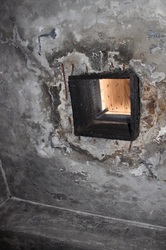

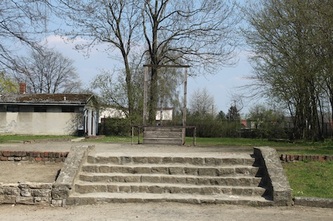

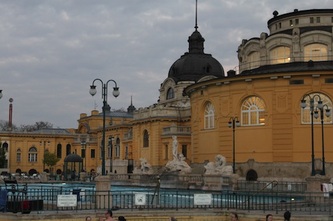


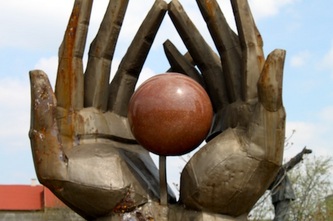
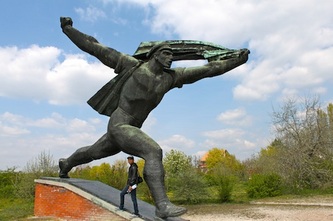
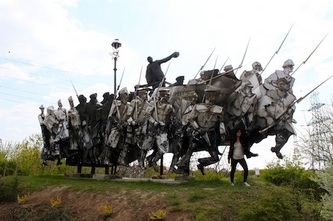
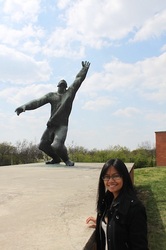
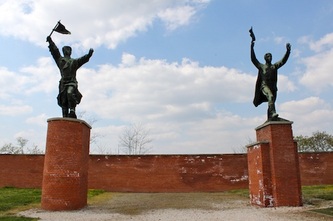
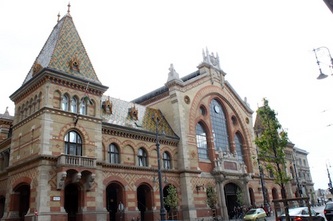
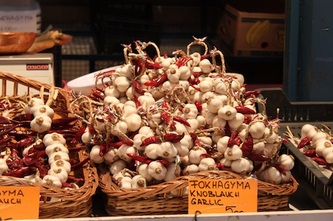
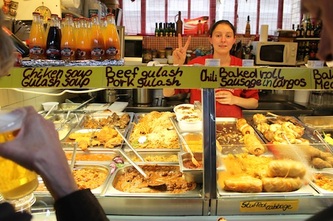
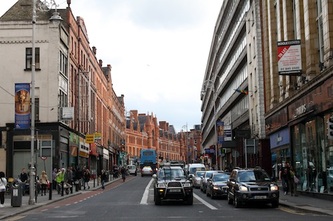
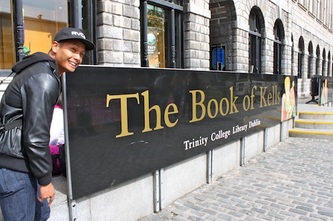
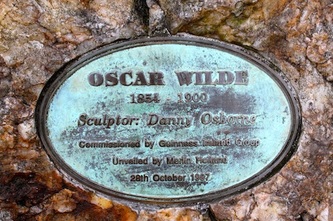
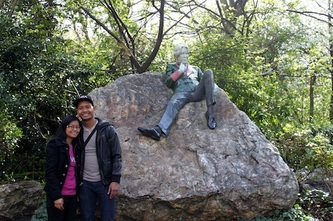
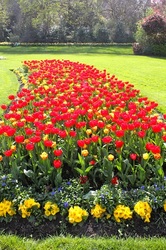

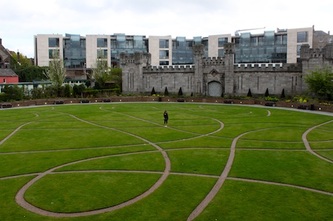
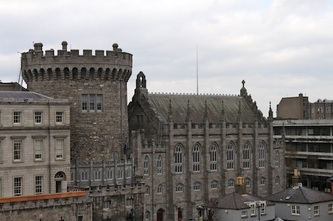
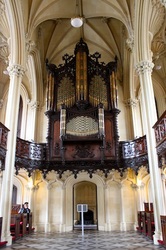
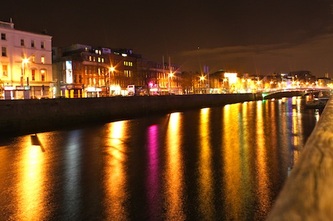
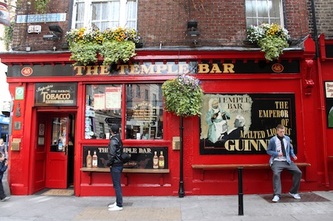
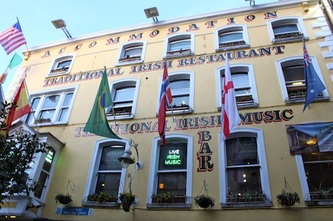

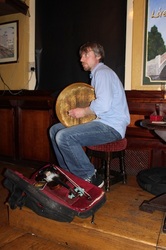
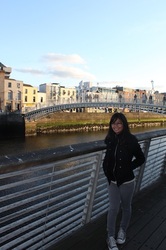
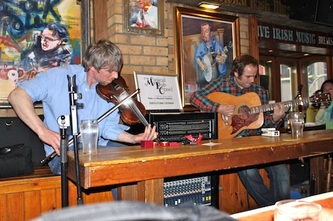

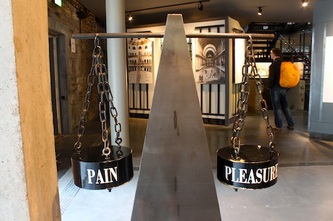
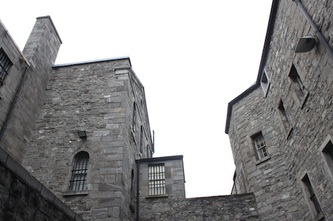
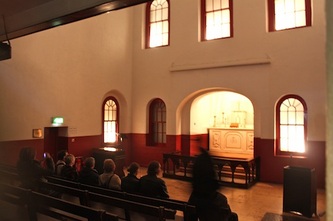
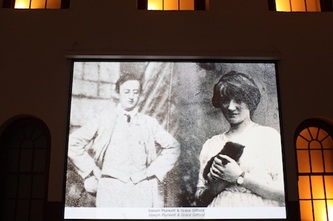
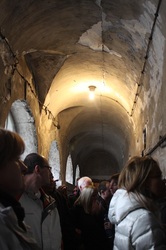
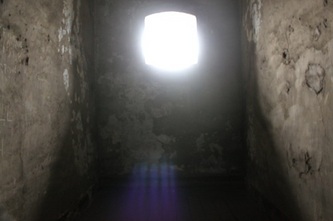
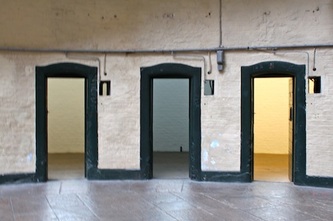

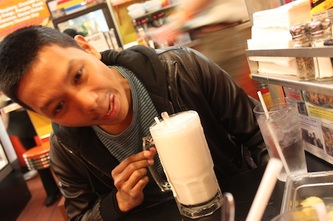

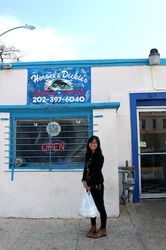
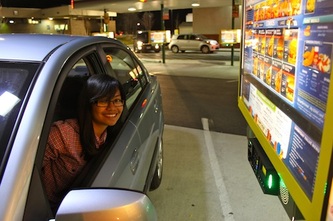
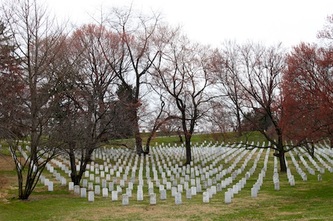
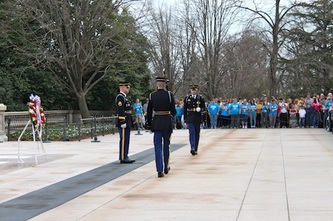

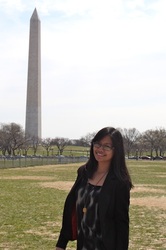
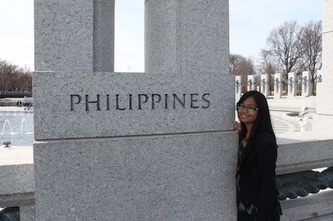
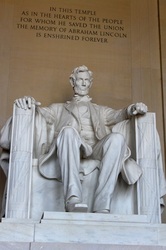
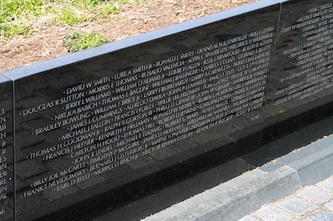
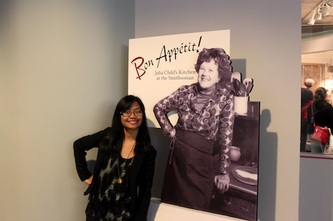

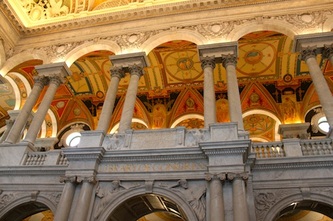
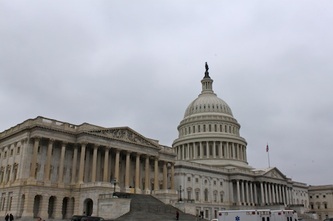
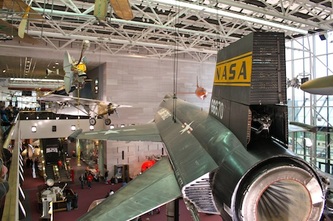
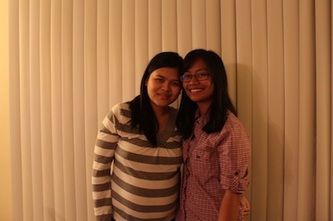
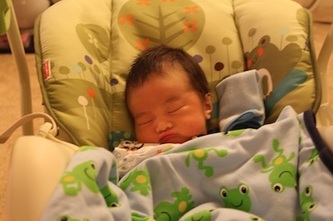
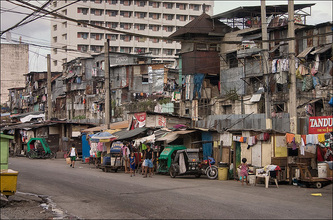



 RSS Feed
RSS Feed